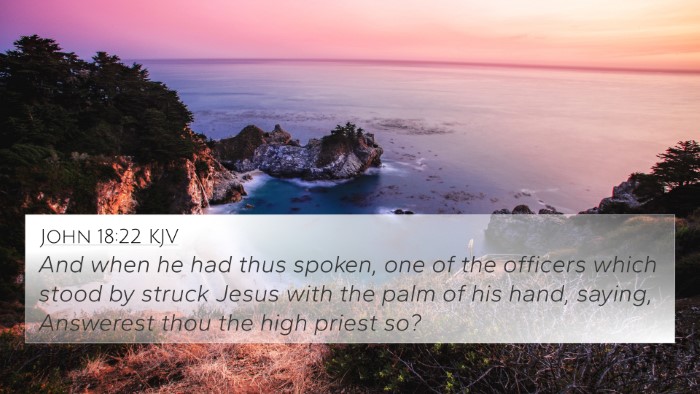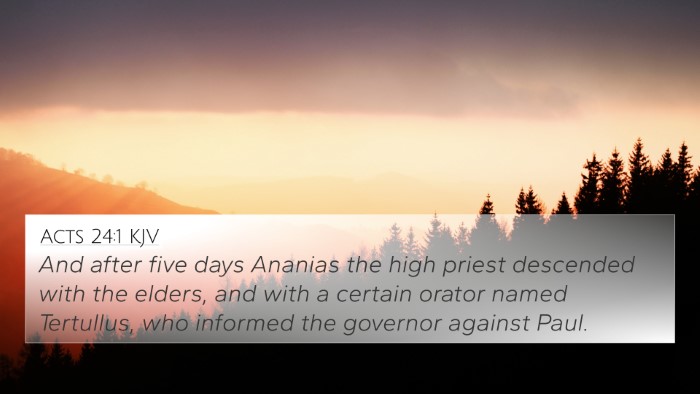Understanding Acts 23:2
Acts 23:2 states: "And the high priest Ananias commanded those who stood by him to strike him on the mouth." This verse captures a significant moment in the apostolic narrative where the Apostle Paul stands before the Sanhedrin, invoking themes of authority, justice, and the initial opposition faced by early Christians.
Contextual Setting
This verse occurs during a pivotal moment in Acts, where Paul is testifying about his faith and his experiences. The high priest Ananias' command to have Paul struck reflects the intense animosity and hostility the early church faced from religious authorities.
Significance of the High Priest’s Command
Matthew Henry notes that the high priest's actions symbolize the corruption and injustice prevalent among the Jewish leadership. He acted out of indignation, demonstrating how those in power often react violently to challenging truths.
Albert Barnes emphasizes that Ananias' behavior exemplifies the opposition faced by true believers. This hostility is not just personal toward Paul but also indicative of a broader aversion to the Christian message.
Adam Clarke explains that being struck on the mouth was a serious insult, highlighting the severity of the high priest's authority and the willingness to silence dissent by force.
Theological Implications
The event serves as a microcosm of the struggle between truth and authority. By striking Paul, Ananias sought to silence the truth of the Gospel, which aligns with broader Biblical themes where God’s messengers face persecution. This connection is seen when comparing Acts 23:2 to:
- Matthew 5:10-12: "Blessed are those who are persecuted for righteousness' sake..." - highlighting the blessedness of suffering for the sake of truth.
- John 15:20: "If they persecuted Me, they will also persecute you..." - drawing parallels between Jesus’ experience and Paul’s current affliction.
- 1 Peter 2:23: "When He was reviled, He did not revile in return..." - illustrating the response of a believer in the face of aggression.
- Acts 5:40-41: "They agreed with him; and when they had called for the apostles and beaten them..." - reflecting the patterns of persecution faced by the apostles.
- Romans 8:31-39: This passage reassures believers of God’s unwavering love, despite opposition.
- 2 Corinthians 11:24-26: Here, Paul recounts his own sufferings, which signify the hardships faced in spreading the Gospel.
- Hebrews 11:36-38: This passage describes the sufferings of prophets and believers, affirming the continuity of persecution throughout Biblical history.
Cross-Referencing Biblical Texts
Understanding Acts 23:2 benefits greatly from cross-referencing other sections in the Bible. These connections can help elucidate themes of conflict, authority, and the standing of believers under pressure:
- John 16:2: "They will put you out of the synagogues; indeed, the hour is coming when whoever kills you will think he is offering service to God." - Further underlining the expectation of persecution.
- Acts 7:54-60: The stoning of Stephen, another powerful testimony of persecution against believers.
- Revelation 2:10: "Do not fear what you are about to suffer..." - offering assurance amidst suffering for one’s faith.
- Matthew 10:16: "Behold, I am sending you out as sheep in the midst of wolves..." - the metaphor of vulnerability amidst danger.
Conclusion
Acts 23:2 is a poignant reflection of the trials faced by early Christians, symbolizing the broader spiritual battle between truth and oppressive authority. The cross-references highlight recurring themes of suffering and the cost of discipleship throughout the Bible.
By utilizing a bible cross-reference guide, believers can explore these themes deeper, tracing connections and enhancing their understanding of scripture. This not only enriches personal study but also aids in responsibilities such as bible sermon preparation.








